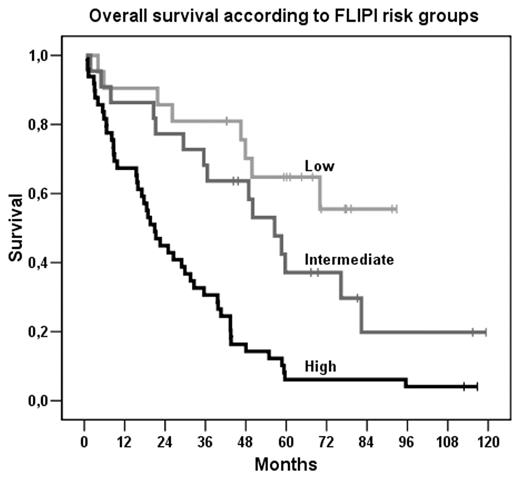Abstract
Background: The International Prognostic Index (IPI) is the most commonly used prognostic model in mantle cell lymphoma. However, the prognostic value of IPI is limited. The recently published Follicular Lymphoma International Prognostic Index (FLIPI) is built on variables (age, stage, lactic dehydrogenase, anemia, and nodal disease) which also are pertinent to mantle cell lymphoma. This study was conducted to evaluate the prognostic value of FLIPI in patients with mantle cell lymphoma.
Patients and Methods: A population-based series of 93 patients with mantle cell lymphoma diagnosed in a 7-year period were studied. End points of the study were response to therapy, overall survival, and failure-free survival according to IPI and FLIPI.
Results: Applied to the whole series, FLIPI identified 3 risk groups with markedly different outcome with 5-year overall survival rates of 65%, 42%, and 8%, respectively (P < .0001; log-rank 28.13; figure below). Notably, the high-risk group comprised 53% of patients. In contrast, IPI only allocated 16% of cases to the high-risk group and had a lower overall predictive capacity (log-rank 24.8). When both FLIPI and IPI were included in a multivariate analysis, only FLIPI was related to survival. In patients treated with CHOP-based regimens (n = 45) FLIPI also had superior predictive capacity compared to IPI (log-rank, 18.51 versus 11.37), and again only FLIPI retained significance in multivariate analysis. Multivariate analysis of failure-free survival also identified FLIPI, and not IPI, as independently significant.
Conclusion: FLIPI is the superior prognostic model as compared to IPI and should be the preferred clinical prognostic index in mantle cell lymphoma.
Overall survival according to FLIPI risk groups
Author notes
Corresponding author


